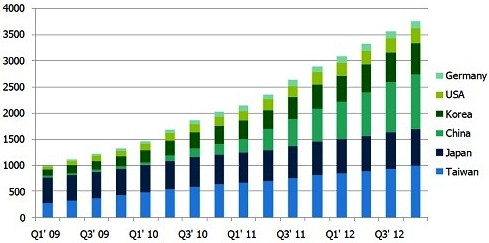 The latest report published by the market research institution Displaybank on the 27th pointed out that China's LED market is experiencing extraordinary growth. With local LED manufacturers continuously increasing the investment scale of the LED industry, it is expected to become the world's largest installed capacity of MOCVD equipment in 2012.
The latest report published by the market research institution Displaybank on the 27th pointed out that China's LED market is experiencing extraordinary growth. With local LED manufacturers continuously increasing the investment scale of the LED industry, it is expected to become the world's largest installed capacity of MOCVD equipment in 2012. Displaybank pointed out that the number of MOCVD equipment in the mainland accounted for only 3% of the world's total in 2009, and it has increased dramatically to 15% in the second quarter of 2011. According to the current investment plans of mainland LED manufacturers, the number of MOCVD equipment in mainland China will be the first in 2012. Four Seasons ranks first in the world.
As a rising star in the LED industry, China currently lags behind other countries in LED manufacturing technology, but actively absorbs talents from advanced countries such as Taiwan, and through government support, overseas investment, and the expansion of existing manufacturers, and After the second quarter of 2010, large-scale investment in equipment will continue. In particular, as China's domestic demand continues to increase, its growth rate will continue to accelerate.
Accumulated installed capacity of world MOCVD equipment forecast In addition to the mainland, Taiwan is also driven by the development of the LED backlight module (BLU) industry for large-size LCDs, and the demand for subsequent MOVCD equipment will continue to increase, especially affiliated with AUO and Chi Mei, respectively. The investment activities of Lextar, a subsidiary of the Electronics (CMI) Group, and KELT (CMLT) are very active.
On the other hand, South Korea also plans to invest in LED lighting business, so it will also increase the purchase of MOVCD equipment. With the development of LED backlighting industry for large-size LCDs in Korea, demand for MOCVD equipment has grown rapidly from 2009 to 2010. Although the LCD TV market has been sluggish recently, it is expected to restart investment plans in response to the needs of the lighting market.
In Japan, due to the high technical level of LED, and the rapid development of the domestic lighting industry, many leading manufacturers are also investing in equipment. However, the larger proportion of investment in LED lighting and automotive applications, but the investment in the field of large-scale backlight is also increasing.
The Nikkei reported on June 15 that due to the large-scale purchase of MOCVD equipment by mainland manufacturers in 2011 and the purchase of MOCVD equipment in production, the output of LED components in mainland China is expected to surpass Japan in Ming (2012). Taiwan and South Korea leaped to the top of the world.
Brian Bae, senior analyst at Displaybank, said that at present, the global LED lighting market is about to enter a period of high growth, so demand for LEDs is rising rapidly. In this environment, the LED industry not only needs to pay attention to the development of patents, product performance, and quality, but also needs to focus on the trends in the Chinese market that will have a great impact on prices and output.
Dual-band WiFi module refers to the WiFi module that supports both 2.4GHZ and 5GHz bands. The dual-band WiFi module can operate in the 5Ghz band, which is much cleaner and can easily avoid interfering with each other. The advantage of 2.4G is that it has good ability to penetrate the wall, and the disadvantage is that it is easy to be disturbed. The advantages of 5G are strong anti-interference ability, wide band width, high throughput rate, and strong scalability, but the disadvantage is that 5G is only suitable for indoor small-range coverage and outdoor bridge, and the attenuation effect of various obstacles on it is much larger than 2.4g.
Dual-band WiFi module has a stronger and more stable Wifi wireless signal, higher transmission speed, and can make wireless devices more power-saving, to meet the future high-definition and big data wireless transmission needs.
When selecting a dual-frequency WiFi module, we should pay attention to these parameters of the WiFi module: size, package, frequency range, data rate, transmission rate, transmission distance, communication interface, power supply voltage, antenna interface, etc.
Dual frequency WiFi module can well meet the functional needs of users, increase the competitiveness of the product, while the WiFi module is easy to use, can shorten the user product development cycle, speed up the product market! Users can make choices according to actual needs!
Choosing a dual-band WiFi module may need to pay attention to the following points:
(1) Consider the transmission power of the dual-frequency WiFi module
The transmitting power of the WIFI module is generally about 18dBm, and the transmitting power of the high-power WIFI module is about 28dBm.
(2) Transmission rate
Consider whether the dual-band WiFi module supports MIMO technology (that is, allows multiple antennas to send and receive multiple spatial streams simultaneously)
(3) Consider the application interface that dual-band WiFi modules can provide, which is also very important.
(4) According to the requirements of the application scenario to choose the dual-band WiFi module, not the higher the configuration, the better, the application is good, excess waste!
Dual Band Router Module,Dual Band Wifi Module,Dual Band Router Embedded Wifi Module,Gigabit Ethernet Router Module
Shenzhen MovingComm Technology Co., Ltd. , https://www.movingcommtech.com